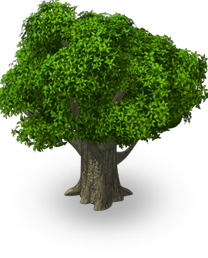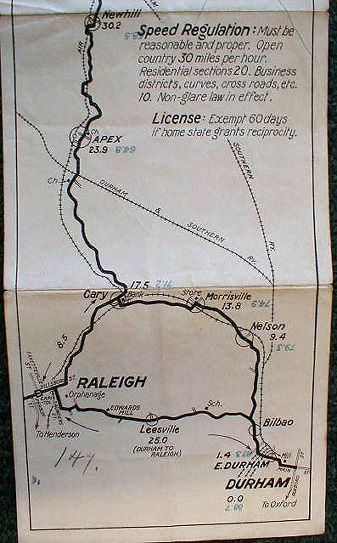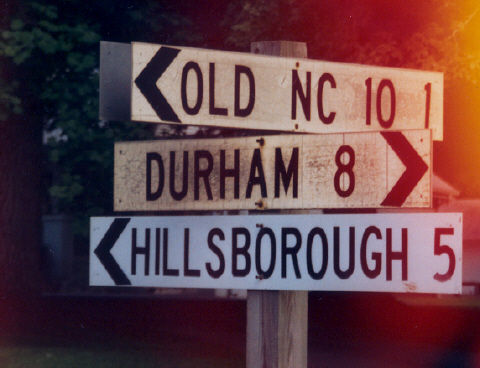Roads To Erwin Mills
Road to Erwin Mills
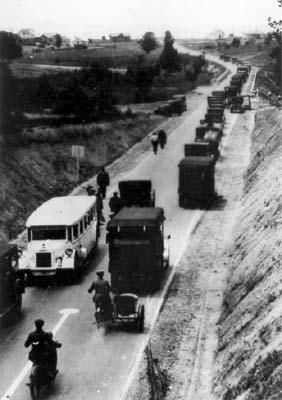
Durham-Raleigh Road in 1924: Motorcycles, convertibles and an inter-city bus travel the two-lane paved road.
Erwin Mills stood at the cross roads: The old Erwin Road approached from Chapel Hill and crossed old NC 10 where the railroad bridge crosses Ninth Street -- near the street car terminus on West Main.
NC 10 (Central Highway) was the first highway to cross the state. Its route followed the ridge between the Neuse River and Cape Fear River basins (from Beaufort to Murphy). Folks said you could walk along NC 10 and never get your feet wet. In Durham, NC 10 followed West Main, turned up Ninth Street and went out Hillsboro Road -- towards other cotton mills in Hillsborough, Haw River, and Salisbury.
When the US started designating national highways in 1927, the "magnificent state route number 10" became US 70. Sections of NC 10 can still be found in western Durham County (near Route 751 and Duke Forest).
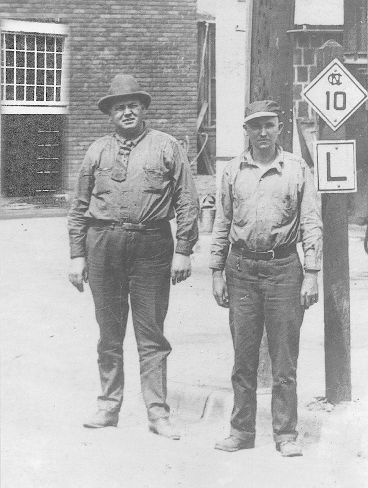
Ralph "Hap" Dennis and Bannie Chesnutt standing in front of Haps Atlantic Gasoline Service Station, at the corner of Ninth and Markham. Note the "NC 10" sign. The large "L" indicted left turn. In the early years, the state also used "R" signs for right turns. Today, the old brick building is Barnes Supply (ca. 1926). Photo courtesy of Ralph and Joyce Dennis.
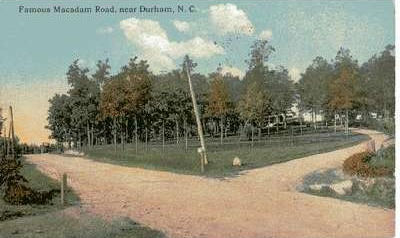
Old road on the outskirts of West Durham (1913).
1923 AAA map of the Triangle area.
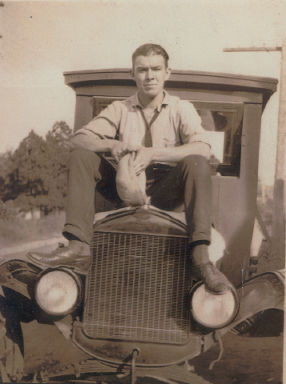
John Guy Eubanks sitting on his hood, Erwin Road (so named because it ended at Erwin Mills). John and his wife, Eula, lived at 402 Case Street (the only house still standing on Case Street, next to Duke School for Children).
"We would watch the cars go up and down Erwin Road. This was great for me at 13. These cars were mainly on their way to "the Blue Light" on Erwin Road. This was a popular hang out for boys! I was certainly in heaven." -Holly Marlow Hall (grew up in Old West Durham)
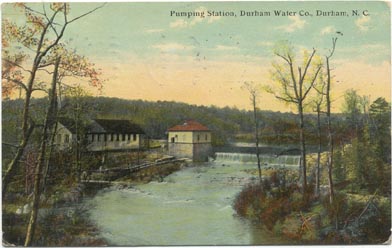
Old pump station northwest of the mill village. When Erwin Mills was built, Fire Station No. 2 was moved to Ninth Street.
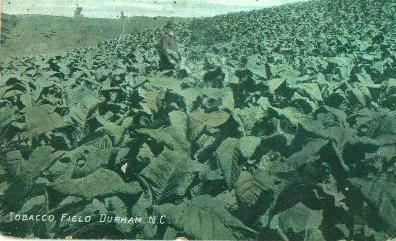
To diversify its tobacco holdings, the Duke family invested in the Erwin
Cotton Mills -- near its tobacco factories, also on West Main Street.
Like its other operations, the Duke's built their mills near the rail
road tracks.
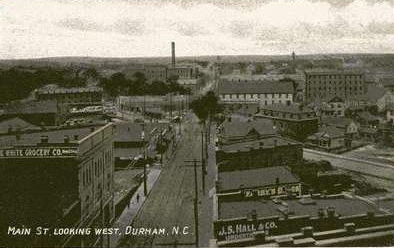
All roads lead downtown. Durham was booming by 1910 (view towards the
tobacco district and Erwin Mills).
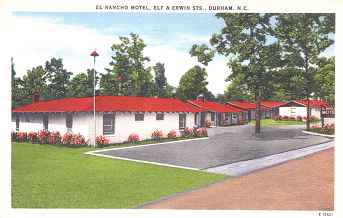
The old Elf Motel on Erwin Road. Today a large Duke parking deck stands
here, across the street from the Medical Center and the state's busiest
heliport. A regional rail station is proposed for the area around Elf,
Elder and Elba streets. Times have changed.
"They had turned away from the centre of the dreary tobacco town.
For a quarter of an hour they had walked briskly through drab autumnal
streets, descending finally a long rutted hill that led them, past a
thinning squalor of cheap houses, almost to the outskirts. It was three
weeks before Christmas: the foggy air was full if chill menace. There
was a brooding quietness, broken by far small sounds. They turned into
a sordid little road, unpaved, littered on both sides... it was a road
of rickets."
--Thomas Wolfe, writing in his autobiographical novel, 'Look Homeward
Angel' -- describing his walk through West Durham on his way to Chapel
Hill.
Did you know? Chapel Hill's Carolina Inn opened in
1924 and was donated to the University in 1935 by
Erwin Mills. Nearby, the Chapel of the Cross was the
gift of William A. Erwin, first manager of the mills
on Ninth Street.

In the 1950s, the bridges along old NC 10 (between Hillsborough and NC 751) were the original, one-lane "Cameron Morrison" models of the early 1920s. Historian David Southern recalls thrilling trips down that road with its hairpin turns, railroad trestles, and narrow bridge over Stone's Creek.

Route from West Durham to Charlotte, including Old NC 10 to Yadkin River. (1926 Mixer's Road Guide)
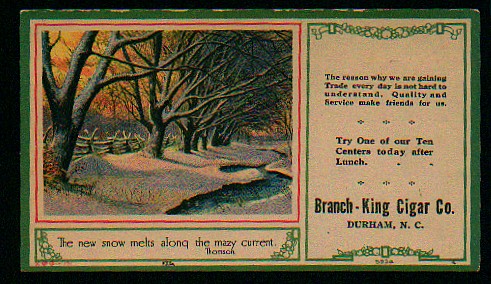
Calendar from Branch-King Cigar Co. in Durham.
| That Beauty Passes Like a Dream from West Durham Winter, by George Zabriskie (Knopf, 1941) On turning axle creaks the year, the old machinery And they shall hear each day The trees shall bear again On U.S. Seventy, how many cars shall pass, and trucks |
